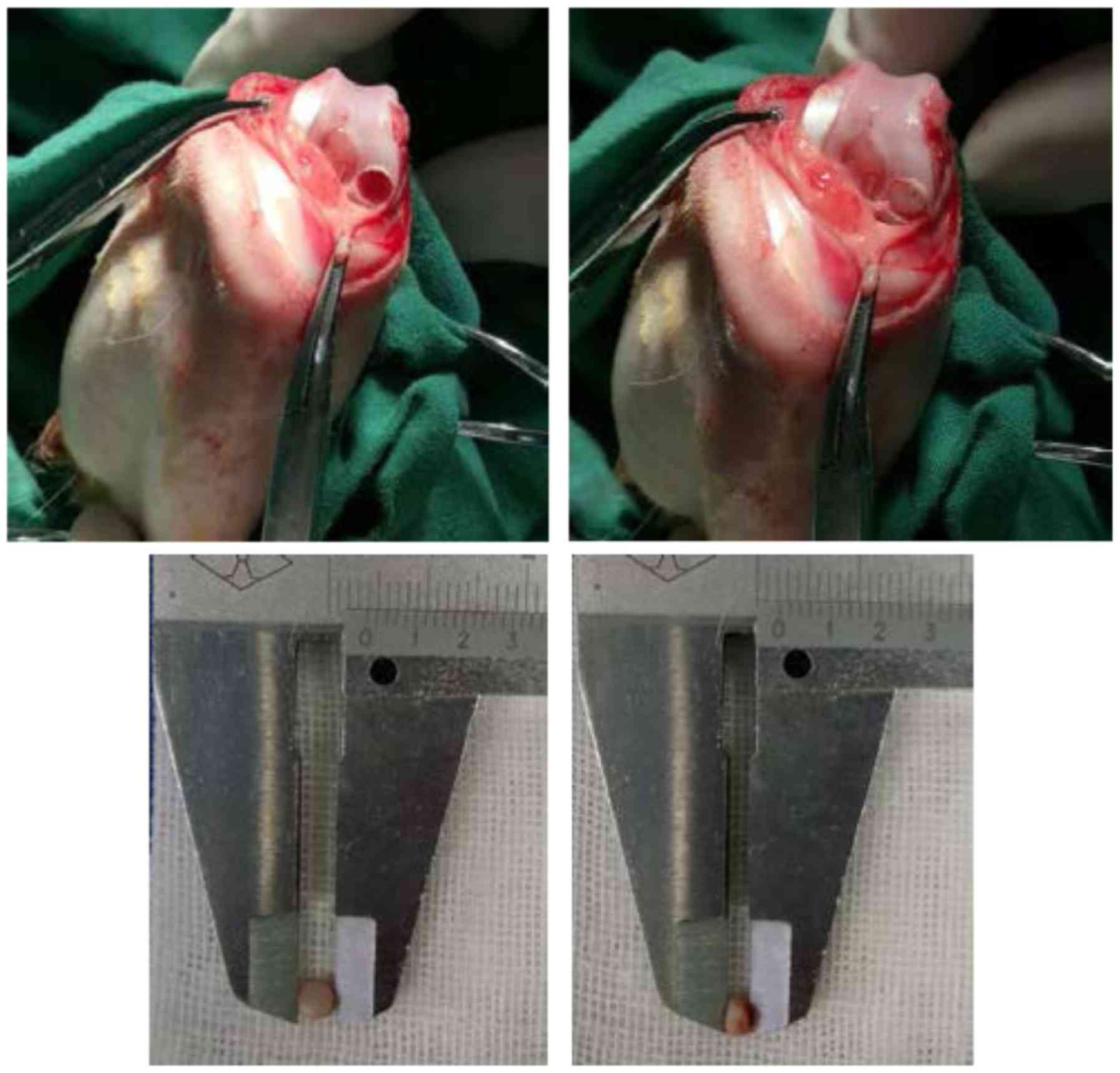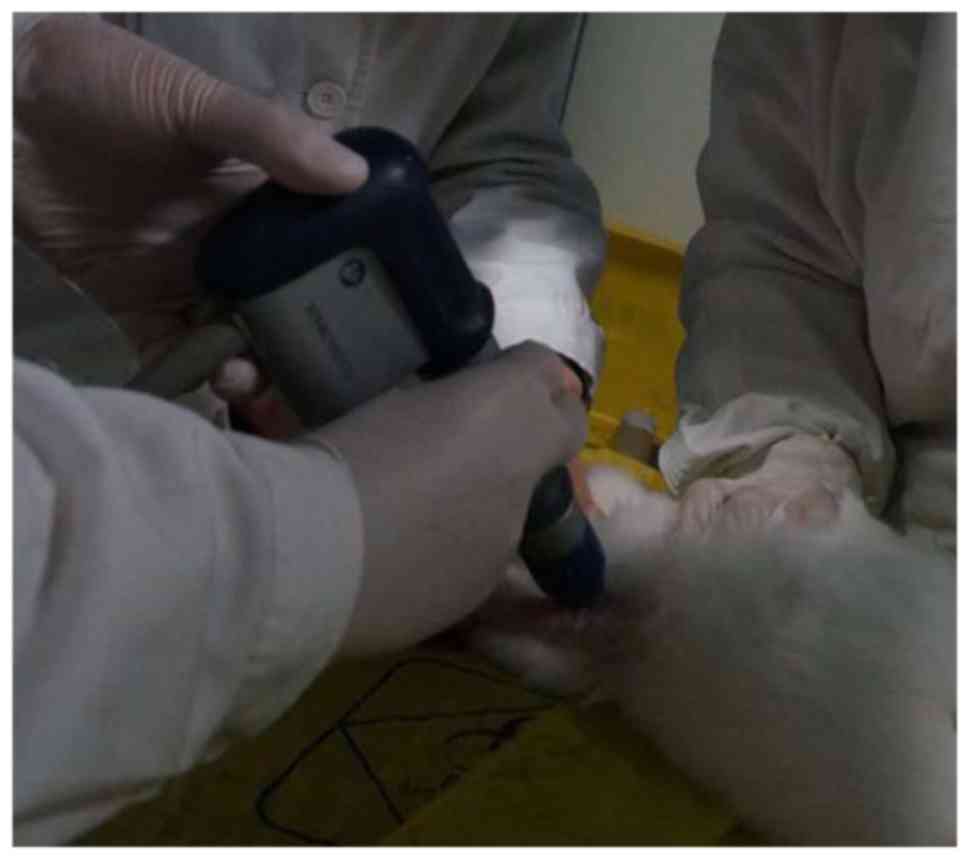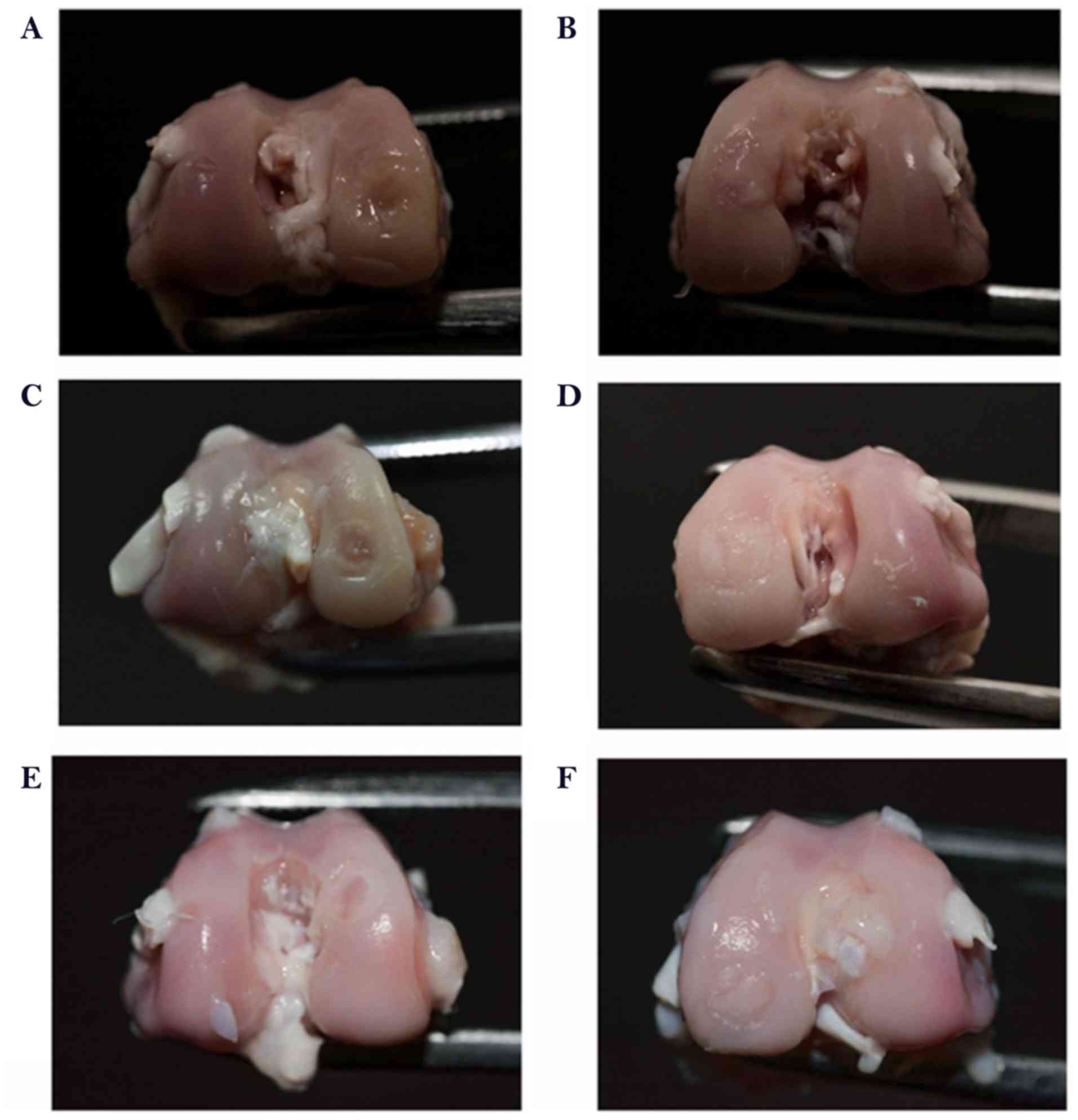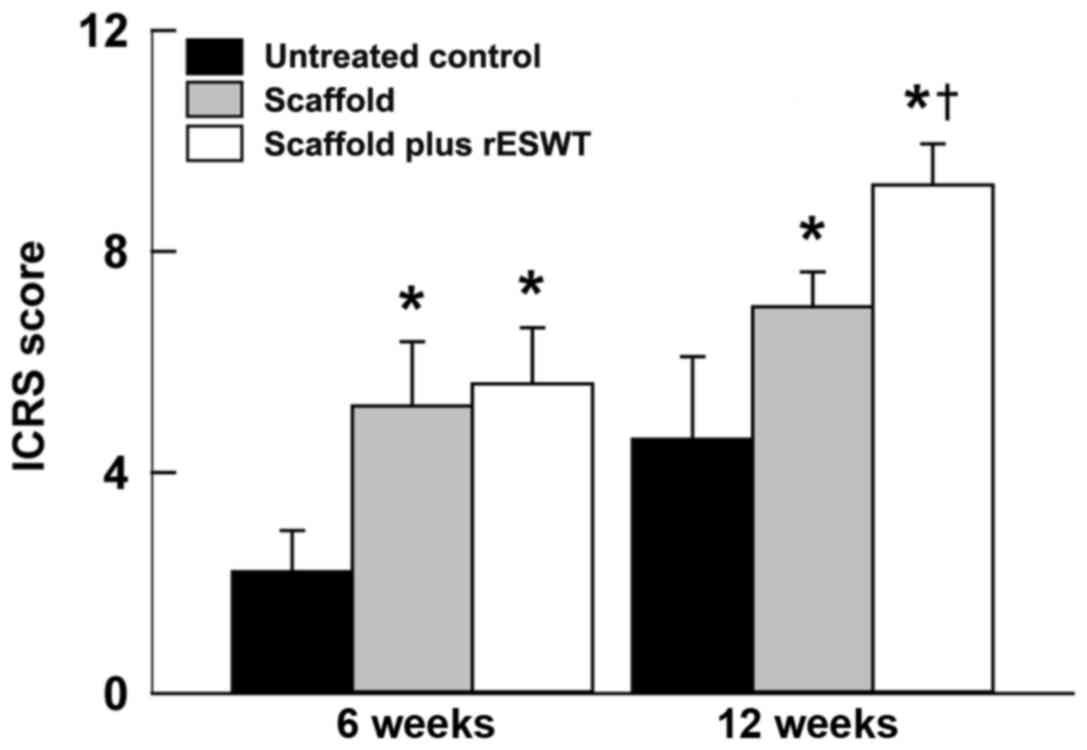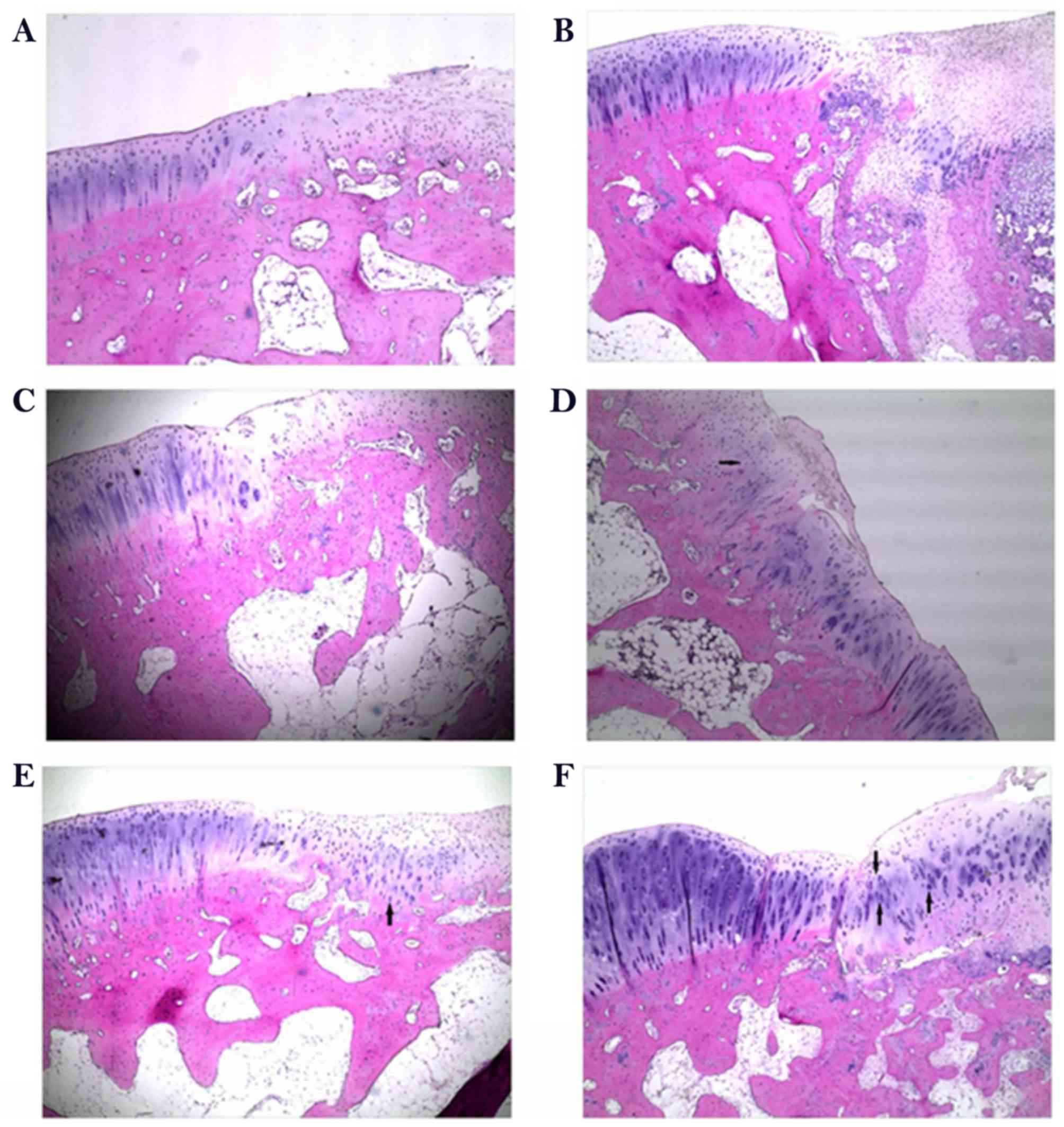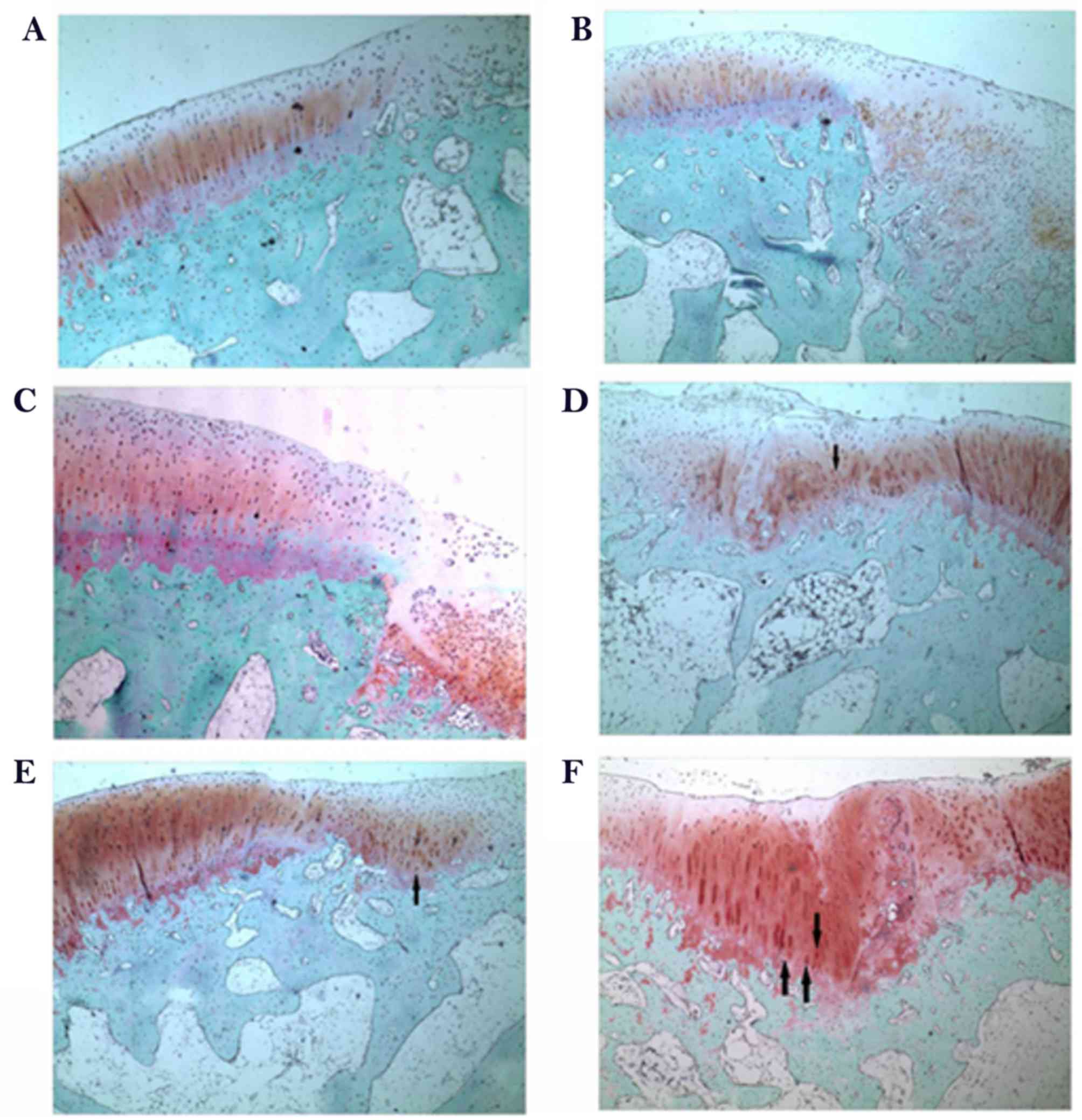|
1
|
Huey DJ, Hu JC and Athanasiou KA: Unlike
bone, cartilage regeneration remains elusive. Science. 338:917–921.
2012. View Article : Google Scholar : PubMed/NCBI
|
|
2
|
Marcacci M, Filardo G and Kon E: Treatment
of cartilage lesions: What works and why? Injury. 44 Suppl
1:S11–S15. 2013. View Article : Google Scholar : PubMed/NCBI
|
|
3
|
Filardo G, Andriolo L, Balboni F, Marcacci
M and Kon E: Cartilage failures. Systematic literature review,
critical survey analysis, and definition. Knee Surg Sports
Traumatol Arthrosc. 23:3660–3669. 2015. View Article : Google Scholar : PubMed/NCBI
|
|
4
|
Okano T, Mera H, Itokazu M, Okabe T, Koike
T, Nakamura H and Wakitani S: Systemic administration of
granulocyte colony-stimulating factor for osteochondral defect
repair in a rat experimental model. Cartilage. 5:107–113. 2014.
View Article : Google Scholar : PubMed/NCBI
|
|
5
|
Khorshidi S and Karkhaneh A: A review on
gradient hydrogel/fiber scaffolds for osteochondral regeneration. J
Tissue Eng Regen Med. 12:e1974–e1990. 2018. View Article : Google Scholar : PubMed/NCBI
|
|
6
|
Kon E, Roffi A, Filardo G, Tesei G and
Marcacci M: Scaffold-based cartilage treatments: With or without
cells? A systematic review of preclinical and clinical evidence.
Arthroscopy. 31:767–775. 2015. View Article : Google Scholar : PubMed/NCBI
|
|
7
|
Qi H, Jie YS, Chen L, Li QH, Gao XS and
Sun L: Repair of articular defects in the knee with a cell-free
scaffold. Orthopaedic Journal of China (Chinese). 23:1303–1309.
2015.
|
|
8
|
Qi H, Jie YS, Chen L, Jiang J, Gao XS and
Sun L: Preparation of acellular dermal matrix as a kind of scaffold
for cartilage tissue engineering and its biocompatibility. Zhongguo
Xiu Fu Chong Jian Wai Ke Za Zhi. 28:768–772. 2014.(In Chinese).
PubMed/NCBI
|
|
9
|
Qi H, Sun L, Chen L, Jie YS and Gao XS:
Technics of hair removal-decellularization-reconstruction to build
cartilage repair carrier. Orthopaedic J China (Chinese).
22:151–157. 2014.
|
|
10
|
Qi H, Jie YS, Chen L, Tao JF, Jiang J and
Sun L: Comparison of scaffolds for chondrocyte implantation with
two kinds of cross-linking agents. Chin Med Biotechnol (Chinese).
8:408–413. 2013.
|
|
11
|
Imamura M, Alamino S, Hsing WT, Alfieri
FM, Schmitz C and Battistella LR: Radial extracorporeal shock wave
therapy for disabling pain due to severe primary knee
osteoarthritis. J Rehabil Med. 49:54–62. 2017. View Article : Google Scholar : PubMed/NCBI
|
|
12
|
Hochstrasser T, Frank HG and Schmitz C:
Dose-dependent and cell type-specific cell death and proliferation
following in vitro exposure to radial extracorporeal shock waves.
Sci Rep. 6:306372016. View Article : Google Scholar : PubMed/NCBI
|
|
13
|
Schmitz C, Császár NB, Milz S, Schieker M,
Maffulli N, Rompe JD and Furia JP: Efficacy and safety of
extracorporeal shock wave therapy for orthopedic conditions: A
systematic review on studies listed in the PEDro database. Br Med
Bull. 116:115–138. 2015.PubMed/NCBI
|
|
14
|
Mainil-Varlet P, Aigner T, Brittberg M,
Bullough P, Hollander A, Hunziker E, Kandel R, Nehrer S, Pritzker
K, Roberts S and Stauffer E: International Cartilage Repair
Society. Histological assessment of cartilage repair: A report by
the histology endpoint committee of the international cartilage
repair society (ICRS). J Bone Joint Surg Am. 85-A (Suppl)2:S45–S57.
2003. View Article : Google Scholar
|
|
15
|
Li X, Ding J, Wang J, Zhuang X and Chen X:
Biomimetic biphasic scaffolds for osteochondral defect repair.
Regen Biomater. 2:221–228. 2015. View Article : Google Scholar : PubMed/NCBI
|
|
16
|
Dahlin RL, Kinard LA, Lam J, Needham CJ,
Lu S, Kasper FK and Mikos AG: Articular chondrocytes and
mesenchymal stem cells seeded on biodegradable scaffolds for the
repair of cartilage in a rat osteochondral defect model.
Biomaterials. 35:7460–7469. 2014. View Article : Google Scholar : PubMed/NCBI
|
|
17
|
Jeon JE, Vaquette C, Theodoropoulos C,
Klein TJ and Hutmacher DW: Multiphasic construct studied in an
ectopic osteochondral defect model. J R Soc Interface.
11:201401842014. View Article : Google Scholar : PubMed/NCBI
|
|
18
|
Armiento AR, Stoddart MJ, Alini M and
Eglin D: Biomaterials for articular cartilage tissue engineering:
Learning from biology. Acta Biomater. 65:1–20. 2018. View Article : Google Scholar : PubMed/NCBI
|
|
19
|
Maia FR, Carvalho MR, Oliveira JM and Reis
RL: Tissue engineering strategies for osteochondral repair. Adv Exp
Med Biol. 1059:353–371. 2018. View Article : Google Scholar : PubMed/NCBI
|
|
20
|
Wang CJ: An overview of shock wave therapy
in musculoskeletal disorders. Chang Gung Med J. 26:220–232.
2003.PubMed/NCBI
|
|
21
|
Wang CJ: Extracorporeal shockwave therapy
in musculoskeletal disorders. J Orthop Surg Res. 7:112012.
View Article : Google Scholar : PubMed/NCBI
|
|
22
|
Lyon R, Liu XC, Kubin M and Schwab J: Does
extracorporeal shock wave therapy enhance healing of
osteochondritis dissecans of the rabbit knee? a pilot study. Clin
Orthop Relat Res. 471:1159–1165. 2013. View Article : Google Scholar : PubMed/NCBI
|
|
23
|
Frisbie DD, Kawcak CE and McIlwraith CW:
Evaluation of the effect of extracorporeal shock wave treatment on
experimentally induced osteoarthritis in middle carpal joints of
horses. Am J Vet Res. 70:449–454. 2009. View Article : Google Scholar : PubMed/NCBI
|
|
24
|
Kim JH, Kim JY, Choi CM, Lee JK, Kee HS,
Jung KI and Yoon SR: The dose-related effects of extracorporeal
shock wave therapy for knee osteoarthritis. Ann Rehabil Med.
39:616–623. 2015. View Article : Google Scholar : PubMed/NCBI
|
|
25
|
Ochiai N, Ohtori S, Sasho T, Nakagawa K,
Takahashi K, Takahashi N, Murata R, Takahashi K, Moriya H, Wada Y
and Saisu T: Extracorporeal shock wave therapy improves motor
dysfunction and pain originating from knee osteoarthritis in rats.
Osteoarthritis Cartilage. 15:1093–1096. 2007. View Article : Google Scholar : PubMed/NCBI
|
|
26
|
Evens DM and Ralston SH: Nitric oxide and
bone. J Bone Miner Res. 11:300–305. 1996. View Article : Google Scholar : PubMed/NCBI
|
|
27
|
Wang CJ, Yang KD, Ko JY, Huang CC, Huang
HY and Wang FS: The effects of shockwave on bone healing and
systemic concentrations of nitric oxide (NO), TGF-beta1, VEGF and
BMP-2 in long bone non-unions. Nitric Oxide. 20:298–303. 2009.
View Article : Google Scholar : PubMed/NCBI
|
|
28
|
Abramson SB: Nitric oxide in inflammation
and pain associated with osteoarthritis. Arthritis Res Ther. 10
Suppl 2:S22008. View
Article : Google Scholar : PubMed/NCBI
|
|
29
|
Hancock CM and Riegger-Krugh C: Modulation
of pain in osteoarthritis: The role of nitric oxide. Clin J Pain.
24:353–365. 2008. View Article : Google Scholar : PubMed/NCBI
|
|
30
|
Studer R, Jaffurs D, Stefanovic-Racic M,
Robbins PD and Evans CH: Nitric oxide in osteoarthritis.
Osteoarthritis Cartilage. 7:377–379. 1999. View Article : Google Scholar : PubMed/NCBI
|
|
31
|
Zhao Z, Ji H, Jing R, Liu C, Wang M, Zhai
L, Bai X and Xing G: Extracorporeal shock-wave therapy reduces
progression of knee osteoarthritis in rabbits by reducing nitric
oxide level and chondrocyte apoptosis. Arch Orthop Trauma Surg.
132:1547–1553. 2012. View Article : Google Scholar : PubMed/NCBI
|
|
32
|
Du Q, Park KS, Guo Z, He P, Nagashima M,
Shao L, Sahai R, Geller DA and Hussain SP: Regulation of human
nitric oxide synthase 2 expression by Wnt beta-catenin signaling.
Cancer Res. 66:7024–7031. 2006. View Article : Google Scholar : PubMed/NCBI
|
|
33
|
Nguyen LT, Sharma AR, Chakraborty C,
Saibaba B, Ahn ME and Lee SS: Review of prospects of biological
fluid biomarkers in osteoarthritis. Int J Mol Sci. 18:E6012017.
View Article : Google Scholar : PubMed/NCBI
|
|
34
|
Li N, Rivéra-Bermúdez MA, Zhang M, Tejada
J, Glasson SS, Collins-Racie LA, Lavallie ER, Wang Y, Chang KC,
Nagpal S, et al: LXR modulation blocks prostaglandin E2 production
and matrix degradation in cartilage and alleviates pain in a rat
osteoarthritis model. Proc Natl Acad Sci USA. 107:pp. 3734–3739.
2010; View Article : Google Scholar : PubMed/NCBI
|















